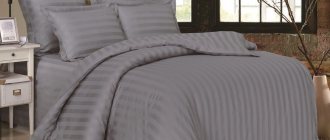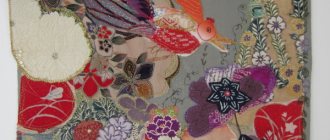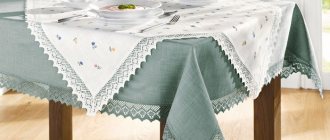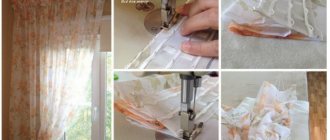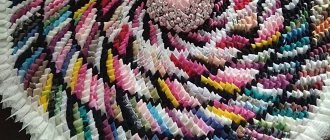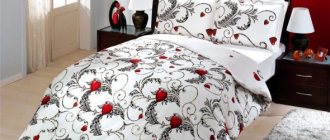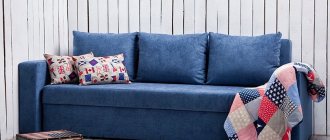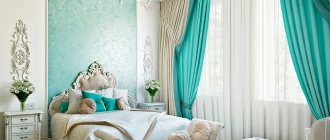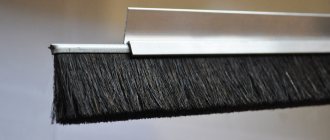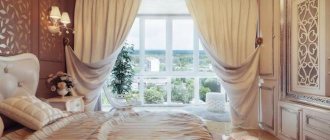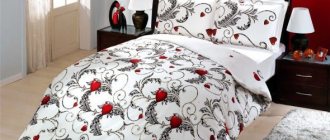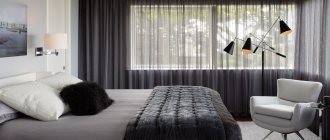Percale is a surprisingly durable fabric. At one time, it was used to make skins for the first aircraft, sails and parachutes, and now products made from it are classified as “premium”.
Initially, this fabric was a 100% cotton fabric made from long-pile threads. Later, silk, polyester and polyester were added to weaving.
The density of modern percale is 100-160 threads per 1 square centimeter .
Sometimes the main material is not cotton, but linen. Variability does not affect the quality in any way. It will not be possible to distinguish one type from another either visually or by touch.
Both are created exclusively from untwisted threads of the same length, hence their smoothness and resistance to wear.
The villi are connected to each other using a special solution. It doesn't wash out. The fabric made from it does not delaminate after washing, but becomes softer. Not afraid of high temperatures.
Definition and general description
Percale is a dense plain weave fabric, smooth, without shine, and washes well. Often used as bedspreads. The density of this material is about 200 (or even more) threads per square meter. cm, which is much more than the fabric used to make bed linen. Percale is such a durable fabric that it was once used to make sails, parachutes, and even the skin of early airplanes.
At first, the fabric was made from pure cotton of long-pile varieties,
later silk and synthetics began to be added to the weaving. Sometimes flax is used as the main material, which does not in any way affect the properties (smoothness and wear resistance) of percale, the main production principle of which is the use of only untwisted threads of the same length.
Modern percale can have a lower density (from 100 threads per sq. cm), it is produced from both carded and combed yarn and can be woven from different fibers, including blended and synthetic. The villi are connected to each other using a special solution that does not separate and is not washed out during washing.
It is believed that the best percale is produced in India, Pakistan, Indonesia, Egypt and Turkey. The largest European producers are France, Italy and Portugal. In Russia, this fabric is produced mainly at enterprises in the Central region - in the Ivanovo, Moscow, Vladimir and Leningrad regions. The largest of them is Teykovsky Cotton Mill (Ivanovo region)
Application
Percale was once used for sails by treating the canvas with linseed oil or organic resin. In aircraft manufacturing, it was impregnated with varnish and used to make airplane wings.
In addition, the material served as the basis for the production of aluminum-coated tent fabric. It was used to make army, hunting and tourist tents, which are now sold at auctions of exclusive items.
Currently, the main purpose of the fabric is for the manufacture of bedding sets. In light industry, it is used to produce impermeable bed sheets, covers for duvets and mattresses, household textiles and clothing. Women's dresses, skirts, blouses and shirts for men are made from thin types of percale. The material is easy to work with and is suitable for models with a complex cut and additional finishing.
The fabric is also used to make flags for ships and various pennants, aprons and protective capes; it is used as a basis for embroidery.
Fabric dyed in the darkest colors feels denser to the touch.
Properties of percale in bed linen
The material has high hygienic qualities. The natural composition ensures temperature balance and moisture removal. The fabric keeps you cool in summer and keeps you warm in winter. Its surface is delicate, soft and smooth. The fabric is recognized as hypoallergenic, suitable for sensitive skin and children's sets. The fabric does not fade or fade, and smooths out well. During use, no pellets appear on the surface. The listed properties are confirmed by the high quality of the material.
Origin story
The name of the fabric most likely comes from the Persian word pargala, which means "rag". Percale came to Europe in the 17th century from India. The first Europeans to master its production were the French, who in 1770 tried to make ship sails from linen soaked in linseed oil.
However, oil was expensive, so percale sails appeared on French ships only in 1806. And in 1814, the Queen of Great Britain’s fleet began to be equipped with such sails.
Oil
How did oil fabric appear and what are its main properties?
more details
Care instructions
First wash
- optimal temperature: 45 degrees.
- do not use bleach.
- don't boil.
- do not soak.
- Before washing, let the laundry rest in a cool room.
- don't starch.
- do not use hard water.
Subsequent washes
- optimal temperature: 80 degrees.
- Use only mild detergents.
Drying and ironing
- squeeze thoroughly.
- Do not leave clean laundry in the washing machine for a long time.
- Both horizontal and vertical hanging methods are suitable.
- When hanging, keep in mind that wet fabric wrinkles a lot.
- You can hang it on both the reverse and reverse sides, as percale does not fade in the sun.
- optimal temperature for ironing: 140-150 degrees.
Fabric composition and properties
Percale, made entirely from natural materials (cotton or linen), tends to wrinkle, which is explained by the special density of the threads.
To avoid this, in our time artificial threads, usually made from special polyester, are often added to natural fibers.
Percale has no equal in its wear resistance - the fabric can withstand up to 1000 washing cycles. Thanks to the weaving method, there are no pills, folds or stretches on the fabric - percale remains smooth and soft even after long use.
The threads are fastened together with a very adhesive solution, so the fabric practically does not shrink (maximum 2%) and does not form lint on the surface. This technological process is called sizing, and a mixture of glycerin, animal fats and potato starch is used as a solution (sizing).
Percale:
Hygienic
Not electrified
Does not cause allergies, so bedding made from this material is suitable for children and people with respiratory tract and skin diseases
Light and gentle
Non-flowing and pliable
All these properties make the fabric ideal for sewing items with decorative elements such as lace inserts.
Recommendations for selection
We do not recommend choosing products made from this fabric if you are not willing to spend money and are not scrupulous. Calico, the closest competitor to percale, costs much less and looks good.
If you need a set made specifically from percale, then before purchasing, be sure to make sure that what you are looking at is not a fake. Since the fabric is elite and has high characteristics, the percentage of people who want to imitate it is extremely high.
The real percale is revealed by its weaving. Take a close look at the products. Are the threads in the product connected using cross-shaped or circular weaving? So it's a fake.
Advantages and disadvantages
Advantages of percale:
- Strength and durability - the service life of percale bed linen reaches 10-15 years.
- Softness.
- Resistant to deformation, sun fading, shedding and pilling.
- Hygroscopicity.
- Breathability.
- Impermeability – does not let feathers and fluff out, maintaining the integrity of the stuffing.
- Hypoallergenic.
- Moderate dirt-repellent effect.
- Aesthetic appearance.
Disadvantages of fabric:
- Possibility of shrinkage (albeit very small - within 2%).
- Possibility of allergic reactions to the components of the dressing (animal fats, glycerin, starch).
- Difficulty in care.
- High price.
Why is percale better or worse than other fabrics?
Among the variety of bedding fabrics, there are several similar to percale. So, they have many common characteristics with poplin, but it is coarser and thicker. Satin and poplin lose next to percale only in durability.
The choice of fabric depends on personal priorities. If you want something beautiful and rich, then this is satin. Practical and inexpensive - calico. For special occasions, with high demands on quality, comfort and durability, percale is needed.
Percale or satin
Percale is a leader in durability and service life. Due to its softness, satin wears out and fades faster. Outwardly it resembles silk, the second one next to it looks duller.
Decide whether percale or satin is better using the positive and negative qualities of these fabrics listed below.
Description of percale products:
- Increased service life;
- Dirt is easily washed off;
- Greatest resistance to washing;
- Quality and appearance are not lost from intensive use;
- The initial stiffness goes away over time;
- "Breathing" properties;
- Wrinkles;
- Comfortable in hot and cold;
- Safe for children;
- Matte surface without reflection;
- High price.
Description of satin linen:
- Fabric with a noble gloss and smoothness;
- Soft and pleasant to the body;
- Recommended for sensitive skin;
- Less susceptible to creasing;
- Poor air permeability, which causes discomfort on hot days;
- In places of friction it becomes shiny;
- Wears out faster.
How is percale different from calico?
Both materials are made from natural raw materials, are aesthetic and practical, and contribute to a comfortable rest.
The difference lies in the quality of the threads used and the weaving technique. For percale, thin and long fibers are prepared to obtain a perfectly smooth, tightly woven fabric. Calico is made from threads that are slightly uneven in thickness, so it is slightly embossed, rough and rougher to the touch. Calico has a matte surface, while the comparable fabric has a glossy surface; due to this, the colors are brighter and more durable. Thin percale is very durable and retains its qualities for a long time.
Calico is considered a budget option, inferior in decorative and tactile parameters, and therefore costs much less. Bleached calico tolerates boiling and sanitary treatment well, which is important for public institutions and hospitals.
Norms and standards for manufacturing
The standards taken into account in the production of technical percales are described in GOST 12125-66. For the production of materials of this GOST, yarn numbers usually above 100 are used, made from the best varieties of long-staple cotton.
According to the requirements of the State Standard, fabrics with a weight per square meter from 60 to 100 g must withstand tensile loads of up to 450 N. Such strength is achieved by observing another standard - the density of the weft and warp (400-500 threads per 1 inch) in plain weave.
Percale for household use is produced in accordance with GOST 31307-2005, which contains the requirements for the consumer properties of the fabric. For example, the air permeability of the material for the manufacture of children's bedding should be at least 100 cubic decimeters per 1 sq.m, and hygroscopicity - at least 15%.
Photo of percale
Photo No. 1 Percale fabric (snow-white bedding)
Photo No. 2 Percale fabric (close-up)
Photo No. 3 Percale fabric (close-up)
Photo No. 4 Percale fabric (peach cut)
Photo No. 5 Percale fabric (with ornaments)
Photo No. 6 Percale fabric (with embroidery)
Photo No. 7 Percale fabric (for couples)
We strongly advise you to familiarize yourself with sets made from other materials before purchasing percale bed linen. In this case, there is something to overpay for, reviews testify to this, but the purchase of goods made from percale can greatly affect your wallet.
How to spot a fake
Due to the great interest shown in percale fabric, it began to be counterfeited very often. To protect yourself from counterfeiting, you should purchase material only at large points of sale, having first examined the surface of the fabric and the label indicating its composition. You should not look for a cheaper product, since this type of material is considered expensive and savings can be achieved by replacing components.
When purchasing, be sure to ask for quality certificates that natural fabrics must have. If the packaging is tight, ask to unwrap it and take a closer look at the purchased product. Natural fabric is made from untwisted threads and has no gaps due to its high density.
What is the difference between percale and poplin, satin and calico?
Despite the commonality of the main component of fabrics - cotton, their properties may vary. This depends on the fiber weave method, density, fiber processing and other factors.
For example, percale and poplin
have the same weave. But to create percale, they use even thinner threads and do not twist them, but comb them out and process them with sizing, which gives the fabric amazing strength with a very small thickness. These materials are also distinguished by the actual density of the weave - in poplin it is significantly lower, which can be seen when you evaluate the fabric for light. As a result, the service life of poplin is approximately 3 times less than that of percale. Percale beats poplin in all respects, except for one thing: it wrinkles significantly more.
Same weave with calico
also does not make these fabrics similar. To make calico, it uses thicker fibers without pre-treatment, which makes the fabric more textured and slightly rougher. And the weaving itself in calico is looser.
With satin
In addition to the thickness of the threads, the fabric is also distinguished by the weaving method. As a result, percale is thinner and equally matte on the front and back sides, while satin is shiny on the front side and matte on the back. The processing of fibers also differs: double twisting for satin and combing and sizing for percale. When comparing fabrics, percale wins slightly in strength, and satin wins in attractiveness due to its shine.
What's better?
It is recommended to select bed linen depending on personal preferences and technical properties. High-density fabrics made using calico or poplin weaving are suitable for the beds of small children. In other cases, it is better to choose a cotton fabric option that is suitable for softness and design.
Despite the presence of synthetic fibers, percale does not contain static electricity.
Varieties of percale
Textile factories produce the following types:
- Technical. It is used to create tents, parachutes, awnings, and specialized industrial covers. Increased values of wear resistance of this type are formed through additional treatment with special solutions. They increase strength and density, and also make the structure almost water and dustproof.
- Domestic. This option is in demand for various consumer needs, therefore it is used for sewing bed linen, clothing, table textiles (tablecloths, napkins, etc.).
The material has very high strength, however, at the same time it is quite light and airy.
Varieties for household use are further divided into several types according to the method of drawing:
- bleached;
- plain painted;
- printed;
- jacquard;
- embroidered.
The fabric has high thermoregulating properties: in the summer it will not be hot to sleep under such underwear, and in the winter it will not be cold.
What else is sewn from percale?
In earlier times, this cotton textile was used to cover airplane wings. At the same time, the material was impregnated with a specialized varnish. Today, in addition to bed linen, percale is used for sewing women's shirts, blouses and dresses.
Percale products will delight their owners with the bright colors, durability and beautiful appearance of this expensive and chic fabric.
Customer Reviews
Most consumers are satisfied with the quality of the products, noting the following points:
- does not slip on the mattress;
- creates a comfortable feeling when in contact with the body;
- immediately after purchase, the linen seems a bit harsh, but after the first wash it becomes pleasantly soft;
- the sets are beautiful both with embroidery, drawings, and in pure white;
- linen does not fade, does not shrink, does not lose shape;
- amazes with the combination of subtlety and density of matter;
- serves for a long time without loss of appearance.
Consumers responded equally well to both ready-made bed linen sets from different manufacturers and pieces of fabric from which they made their own bed linen.
But they all preferred to purchase fabric consisting of natural ingredients. Because the introduction of polyester into the composition leads to a deterioration in the breathability of the fabric and its hygroscopicity, which causes increased sweating during sleep.
Production Features
The fabric is made from combed long cotton fibers. First, the quality of the original spinning material is assessed: the cotton type, thickness, and fiber length are checked. Sometimes, to obtain stable yarn quality, raw materials from different batches are mixed.
The secret of density, strength and other special properties of percale when compared with other natural fabrics is that long-staple varieties of cotton are used in its production. And the fibers are not twisted into threads. As they usually do.
They are also treated with size (an adhesive composition made from a mixture of natural ingredients). Thanks to this procedure, the density and strength of the fibers, and therefore the fabric, increases. Sizing makes the threads smooth, strong, resistant to fading, eliminates hairiness, and prevents yarn breakage.
At the same time, the natural properties of the raw material are completely preserved in the resulting dense and smooth percale fabric, which can withstand repeated washing. The adhesive composition is partially washed away during the production process, although not completely. In any case, its composition is completely safe for humans.
As for the method of weaving the threads, there is nothing unusual here. As with many other fabrics, the cross-weave method is used.
